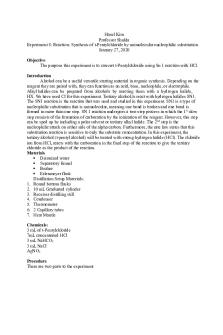Converting Butanol To Butyl Bromide by Nucleophilic Substitution PDF

| Title | Converting Butanol To Butyl Bromide by Nucleophilic Substitution |
|---|---|
| Author | Angie Pratte |
| Course | Organic Chemistry I |
| Institution | New York City College of Technology |
| Pages | 4 |
| File Size | 107.7 KB |
| File Type | |
| Total Views | 146 |
Summary
Converting Butanol To Butyl Bromide by Nucleophilic Substitution Lab report
Introduction, Materials, Methods, Data, Results, Discussion, Conclusion.
...
Description
Experiment: Converting Butanol To Butyl Bromide by Nucleophilic Substitution Date Performed: April 22, 2020 Date Submitted: April 26, 2020 Organic Chemistry CHEM 2223L
Introduction: The purpose of this experiment is to convert Butanol to Butyl Bromide by nucleophilic substitution. The procedure to get Butyl bromide from Butanol is done in two parts. The first part of the experiment involves the formation of n-butyl bromide from 1-butanol. In the second part of the experiment the n-butyl bromide produced in the first part is being converted into n-butyl ethyl ether by using methanol and sodium hydroxide. The reaction for parts 1 and 2 are shown below: Part 1: CH3-CH2-CH2-CH2-OH +NaBr + H2SO3 → CH3-CH2-CH2-CH2-Br+NaHSO4+H2O Part 2: C4H9Br → CH3(CH2)3-O-C2H5
An Alkyl halide is used. The displacement of a hydroxyl group by halide ion is successful only in the presence of a strong acid. 1-butanol is used to be converted into 1-bromobutane with the addition of Sodium bromide and Sulphuric acid. The nucleophile for the reaction is Br- ions. The nucleophile in this lab is generated from an aqueous solution of sodium bromide. The sulfuric acid acts as a catalyst in this reaction. The Sulphuric acid protonates 1-butanol to produce the leaving group, OH, in SN2 reaction. In the second part of the experiment the mechanism of synthesis of ether used is known as the mechanism of Williamson ether synthesis. In this mechanism one alkoxide reacts with alkyl bromide to form ether with two alkyl groups by using a strong base. For the synthesis of n-butyl ethyl ether, both reactions undergo SN2.
Materials:
● 1-butanol
● Anti-bumping granules
● Condenser
● Anhydrous Calcium chloride
● 95% ethanol
● 5% aqueous Sodium bisulfate
● Thermometer
● Anhydrous Magnesium sulphate
● Sulphuric acid
● 10% aqueous Sodium carbonate
● Bunsen burner
● Round bottomed flasks (50cm3 and
● Distilled water
250cm3)
● Sodium bromide ● Separatory funnel ● Sodium hydroxide
Procedure: 1. 27g of sodium bromide, 30cm3 of water and 20cm3 of 1-butanol are placed into a 2. 250cm3 round bottom flask. 3. The mixture is cooled in an ice bath and 25cm3 conc. sulphuric acid is added with continuous swirling. 4. Two or three anti-bumping granules are added and attached with a gas trap to prevent HBr escaping, the round bottom flask is heated vigorously under reflux for 1.5 hours as shown in diagram 1 below. 5. Distill the two layered mixture until the temperature reaches the boiling point of water. 6. The distillate is transferred to a separating funnel and shakes with an equal volume of 5% aqueous Sodium bisulfate. 7. Allow the two layers to separate and wash the organic layer twice with 25cm3 water followed by 10% aqueous sodium carbonate (25cm3 ).
8. The product is dried with 5g Calcium chloride and is filtered into 50cm3 round bottom flask. 9. Anti bumping granules are added and distilled, the material which boiled between 90-105 C is collected. 10. The appearance of product is noted and weight is measured. 11. 4g of Sodium hydroxide and 12cm3 95% of ethanol are added into round bottom flask and is heated under reflux for 20 minutes. 12. 10cm3 n-butyl bromide is added into the mixture through the top of the condenser and the reaction is heated under reflux for 90 minutes. 13. After cooling, the mixture is transferred to a separating funnel and 50cm3 of water is added which has been used to rinse the reaction flask. 14. The mixture is mixed and the lower layer is removed. 15. The washing is repeated for two times with 20cm3 of water. 16. The organic layer is dried with anhydrous Magnesium sulphate and the liquid is filtered into a 50cm3 round bottom flask. 17. The product is distilled slowly; the material which boiled in the range 90-96 C is collected in a pre-weighed flask. 18. The density of the pure ethyl n-butyl ether is determined by pipetting 1cm3 liquid into a pre-weighed measuring cylinder and noting the weight difference....
Similar Free PDFs

Nucleophilic Substitution Lab
- 11 Pages

Factoring by Substitution
- 10 Pages

Converting ER Diagrams to Tables
- 9 Pages

Nucleophilic Substitutions
- 13 Pages

3930 Click- Tert-butanol
- 8 Pages
Popular Institutions
- Tinajero National High School - Annex
- Politeknik Caltex Riau
- Yokohama City University
- SGT University
- University of Al-Qadisiyah
- Divine Word College of Vigan
- Techniek College Rotterdam
- Universidade de Santiago
- Universiti Teknologi MARA Cawangan Johor Kampus Pasir Gudang
- Poltekkes Kemenkes Yogyakarta
- Baguio City National High School
- Colegio san marcos
- preparatoria uno
- Centro de Bachillerato Tecnológico Industrial y de Servicios No. 107
- Dalian Maritime University
- Quang Trung Secondary School
- Colegio Tecnológico en Informática
- Corporación Regional de Educación Superior
- Grupo CEDVA
- Dar Al Uloom University
- Centro de Estudios Preuniversitarios de la Universidad Nacional de Ingeniería
- 上智大学
- Aakash International School, Nuna Majara
- San Felipe Neri Catholic School
- Kang Chiao International School - New Taipei City
- Misamis Occidental National High School
- Institución Educativa Escuela Normal Juan Ladrilleros
- Kolehiyo ng Pantukan
- Batanes State College
- Instituto Continental
- Sekolah Menengah Kejuruan Kesehatan Kaltara (Tarakan)
- Colegio de La Inmaculada Concepcion - Cebu










